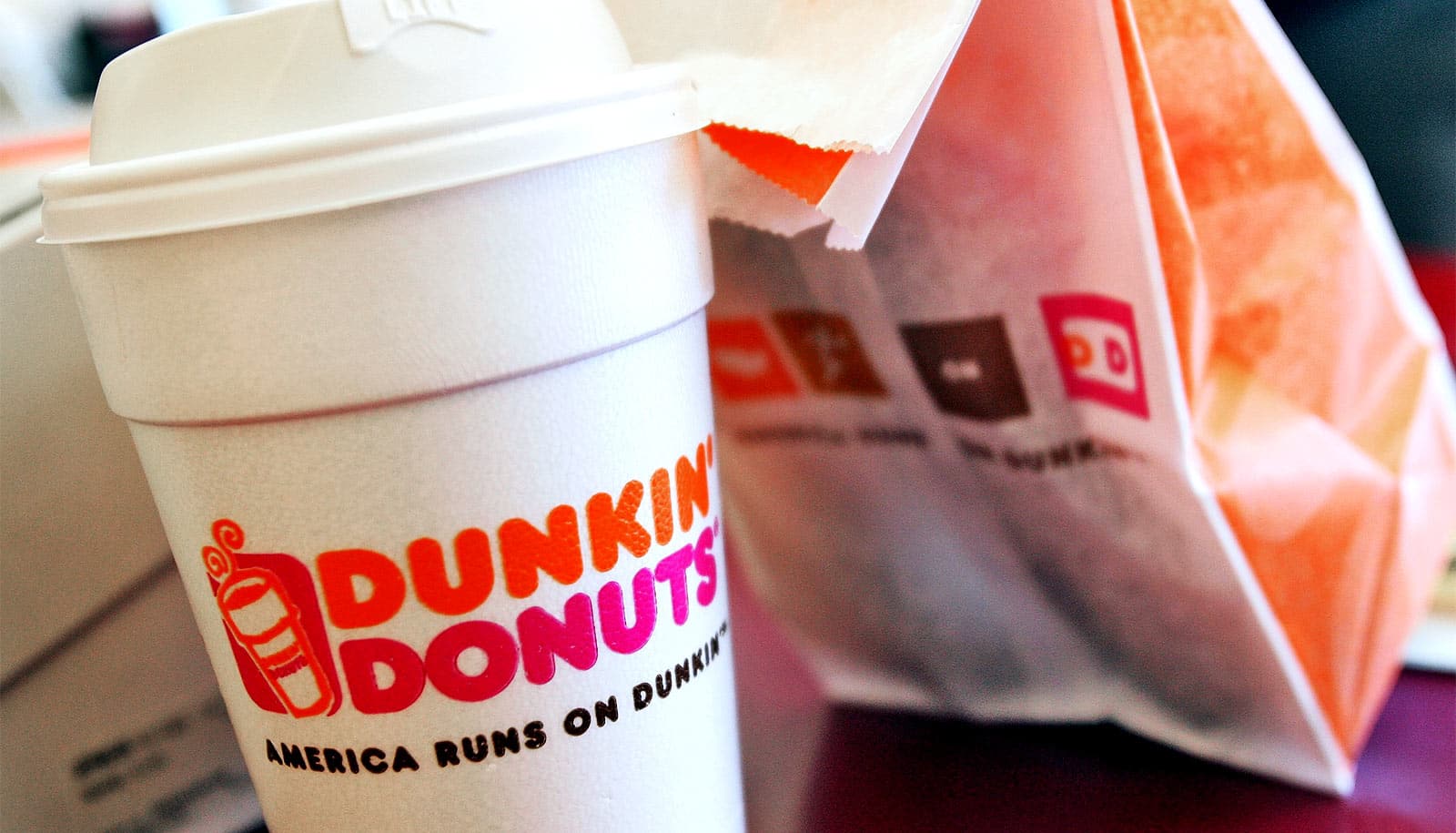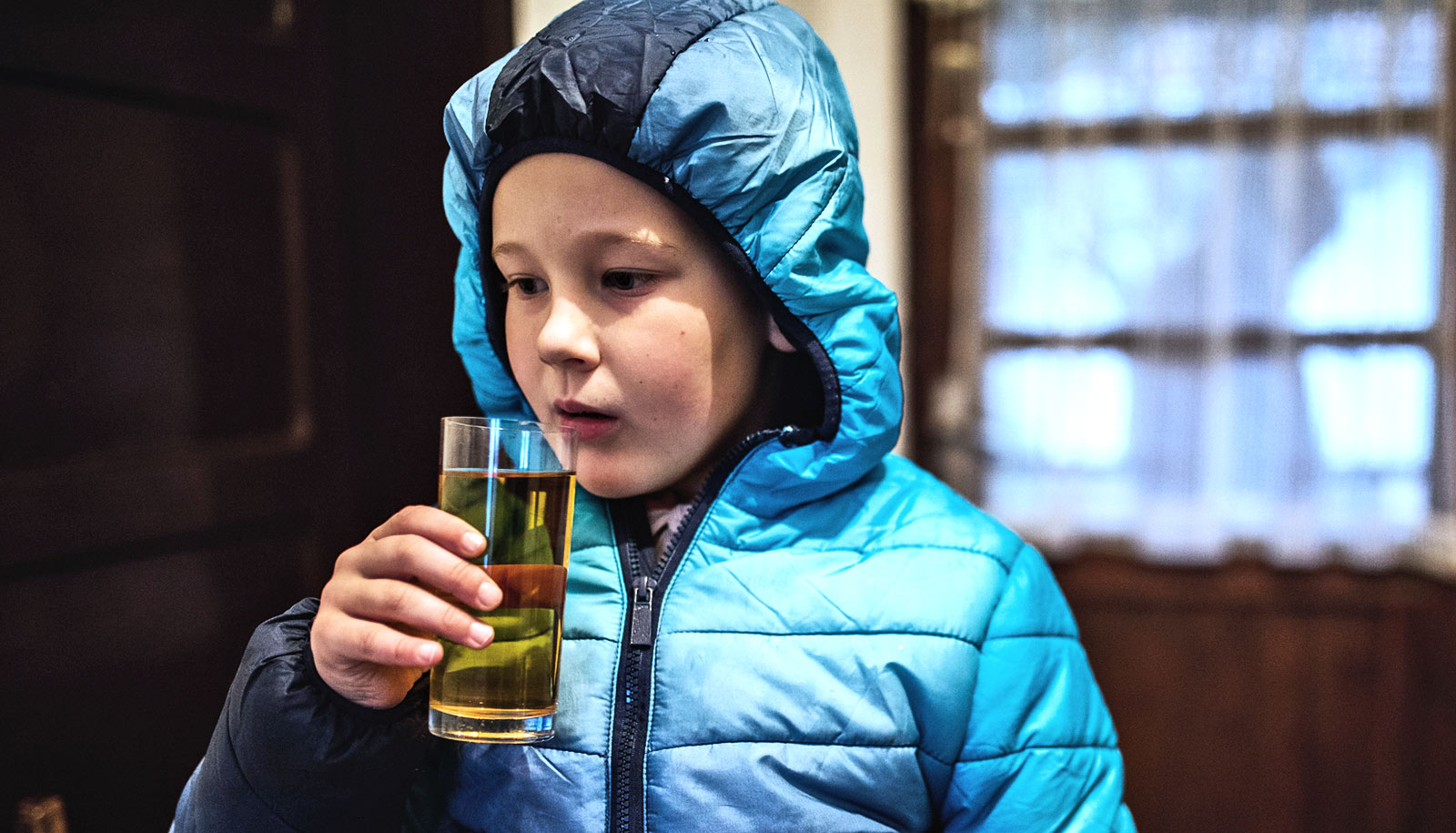Dunkin’ Spiked, a new line of alcoholic iced coffees and teas from the coffee and donut chain Dunkin’, might give youth “too easy an entry point” into alcohol, warns substance use prevention researcher David Jernigan.
The beverages are sold at package and grocery stores from Texas to Maine in flavors like Caramel Iced Coffee and Mango Pineapple Iced Tea Refresher. Dunkin’ says the boozy drinks are “perfect for day or night enjoyment.”
Despite the breezy PR attempt, Jernigan, a professor of health law, policy, and management at Boston University, has real concerns, and says you might want to stick with your regular coffee. Not only does Dunkin’s new line pack a pretty high alcohol punch—as much as a craft beer for the coffees—he says the beverages could be dangerously appealing to underage drinkers.
“We have more places to buy alcohol in Massachusetts than we have Dunkin’ Donuts,” Jernigan says. “This is, among other things, another way to spread the Dunkin’ brand. My concern is just that this is too easy an entry point [to alcohol] for kids who already have loyalty to the brand.”
If it seems a long way from rainbow sprinkled donuts to a 6% ABV beverage, Dunkin’ is just the latest in a long line of family-friendly food and drink names jumping into the liquor aisle.
Mountain Dew, SunnyD, and even Eggo—yes, as in the breakfast waffles—have all released hard drinks in recent years. And that has advocates worried about the message being sent to kids by their favorite brands, not to mention the danger of them accidentally (or intentionally) swigging their parents’ alcoholic SunnyD with their breakfast.
A recent Wall Street Journal article on the blurring lines between adult and kids beverages points to multiple examples of Hard Mountain Dew being placed on shelves next to the regular drink—and even near a toy display. “Some states say adult and children’s drinks are getting too close,” the article says.
But for the companies, they see big money to be made: venerable liquor distiller Brown-Forman’s Jack Daniels and Coca-Cola tie-up was reportedly the most successful launch in its history.
Manufacturers say these products are clearly labeled and marketed for over 21s drinking responsibly, and that they train retailers to stock them correctly. On its website, SunnyD addresses its crossover with an FAQ, “Isn’t SunnyD a kid’s drink?” Its response: the vodka seltzer “was developed specifically for adults 21+ who love the bold one-of-a-kind orange flavor of SunnyD and who also enjoy cocktails.”
Here, Jernigan explores the decisions of Dunkin’ and other kid-friendly brands to make a foray into alcoholic drinks and the trend’s potential impact on youth substance use:
What’s your reaction to the news about Dunkin’ Spiked?
Not a product the world ever needed.
Isn’t mixing caffeine and alcohol a bad idea? The CDC certainly warns against it, saying it may cause people to “become more impaired than they realize.”
With these drinks, they have about the amount of caffeine in them that a Coke would have. It’s not like drinking a cup of coffee, but a third of a cup of coffee. About a little over 10 years ago, the Food & Drug Administration took action toward Four Loko, which at that point had caffeine, guarana, ginseng, and taurine added to it.
The response of Four Loko and similar products was to very quickly remove the stimulants. As a result, for a long time, there were no malt beverages introduced into the US market that had stimulants in them. There was no official ruling, so companies [like Dunkin’] aren’t doing anything illegal, but it might be interesting to try to get a comment from the FDA about their attitude toward these things.
My bigger concern about this, beyond the caffeine, is the brand blurring, and the taking of products and brands that are already popular among young people.
I go to Dunkin’ Donuts and I see plenty of teenagers getting their coffee. It’s a similar thing with products like Hard Mountain Dew. Who loves Mountain Dew? Teenagers. These are brands that have strong brand loyalty among the population that’s not supposed to drink. This is allowing alcohol producers to take advantage of the brand loyalty that Dunkin’ has built up among teenagers.
But these companies will say, “We market them very clearly for responsible drinkers aged over 21.”
Oh, come on. I mean, they can say that all they want, the fact of the matter remains that their marketing is widely accessible and exposed to young people. And furthermore, what they’re getting is the halo effect of the nonalcoholic version. These products have been heavily marketed to everybody and lots of adolescents are drinking them. We’re in the midst of a trend—and from a public health perspective, I don’t think it’s a good trend—of adult beverages crowding in on brands that have built a lot of youth loyalty.
I’ve seen statistics that show youth drinking is declining. Do young people even want these products?
It’s a really good question. One of the things to note, and this is what the reviewers have been saying, is how incredibly sweet these Dunkin’ Spiked products are. And that is a reliable way to get people who don’t like the taste of alcohol to start drinking alcohol. And that’s been the case with the wine coolers, the alcopops, the alcoholic energy drinks, the hard sodas, and so on—you add a lot of sugar.
In terms of young people’s drinking, yeah, we’re in a good situation now, in that this generation of adolescents is drinking less than any cohort since we’ve been monitoring this stuff in the mid-1970s. They’re doing less of all sorts of things that are risky behaviors that teens used to do together.
A lot of people point to the reason for that not being anything wonderful that we’ve done in prevention, but something as simple as the iPhone, which has transformed young people’s lives and led them to relate to each other much more in cyberspace than in real time. Drinking is down, that’s a good thing, but alcohol is still the number one drug among kids.
Is there something regulators could or should be doing about the proliferation or the availability of these products?
The simplest thing would be to update the warning label and make it more effective. We also know much more about what an effective warning label looks like; there’s been a whole lot more research from tobacco on how to do a good warning label.
The latest word from bodies like the World Health Organization is there is no safe level of consumption of alcohol. Well, if a product for which there’s no safe level of consumption is being widely marketed, and you’re the regulatory body, one would think you would want to warn the public about that.
One thing I find really striking with these products is how similar the designs on the labels are between some alcoholic and nonalcoholic drinks. It’s hard to tell which is which, especially from a distance.
I’m looking at the Dunkin’ Spiked can right now and in small letters around the rim, it says 6% alcohol. That alone gives me a bit of pause, because now we’re up in the realm of alcohol strength of the craft beers, we’re on the high end of alcohol content in a malt beverage. So that makes it a higher risk product. They had a decision to make about how much alcohol to put in, [and] they decided to make it a 6% alcohol product. I don’t know why. And it makes it inherently more dangerous than a lower alcohol content product.
You’ve done a lot of research on alcohol advertising and its impact on young people. How does seeing ads for alcoholic products like these influence youth?
What we know from the research—and it’s a substantial body, as it is primarily based on longitudinal studies that follow groups of kids over time—is the more alcohol advertising kids see, the more likely they are not only to start drinking, but to progress from experimentation to heavier drinking. And that has been termed by my colleagues who have reviewed the literature as a causal relationship.
You’ve been campaigning recently for Massachusetts to increase its alcohol tax. Why?
First, Massachusetts has a big alcohol problem. Roughly 5% of deaths, over 3,000 people a year, die because of alcohol use. Second, alcohol is expensive for the state, costing somewhere in the range of $5.6 billion a year. And about 40% of that is paid directly by governments. If you adjust for inflation, what you get is for every alcoholic drink that’s consumed in Massachusetts, it generates $3.34 in costs. And we take in less than a nickel in state taxes.
That’s not fair. All of us, the nondrinkers, the other industries, we’re all paying for alcohol, even if we don’t drink, even if we don’t cause a problem.
And then the third point, our taxes are way out of date. The last time we raised them in Massachusetts, Jimmy Carter was the president. They’ve lost 72% of their value since then. We have the lowest taxes on beer of any of the New England states.
We’ve been asleep at the wheel, and it’s part of why we have such big alcohol problems. I was involved in the Maryland campaign, where we passed a 3% sales tax on alcohol in 2011. It’s raising $135 million a year going to all sorts of good causes. And it led to a 3.5% drop in consumption, a 6% drop in alcohol-impaired drivers on Maryland roadways, and a 24% drop in gonorrhea rates.
Source: Boston University

